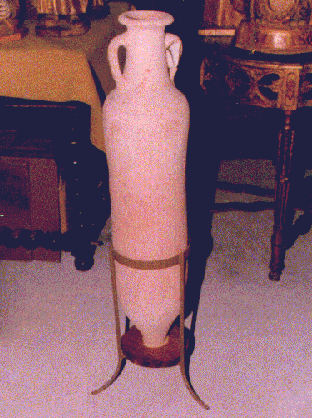|
| Amphora from Setúbal: 4th century AD |

From the 3rd to the 5th centuries the previous amphora shape was changed to one with an even longer, narrower, body and narrower neck.
The reasons for the change are unknown, but were perhaps designed to make the vessels easier to handle (frescoes from Pompeii, and decorated tiles from Ostia, the port of Rome, show amphoras being hung from walls, humped under the arm, over the back and on poles, as well as loaded onto ships).
This amphora was never exported, but used instead to conceal more than 7000 late Roman coins. The reasons are unknown, though it must be remembered that there were no banks as we understand them, and hoarding was the best way to keep one's wealth safe. The coins were never retrieved by the owner, but found inside when the vessel was discovered.
© 1998 Oxfordshire Museum Service, Setúbal Museums and the Benaki Museum